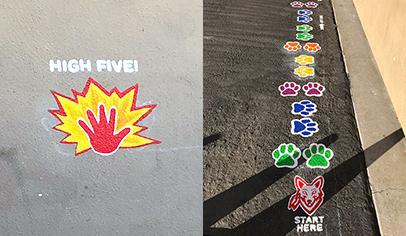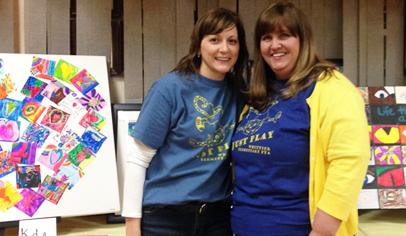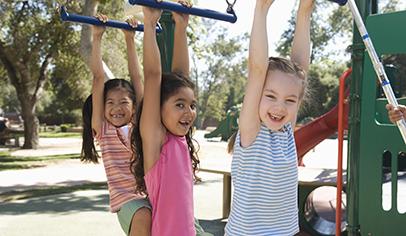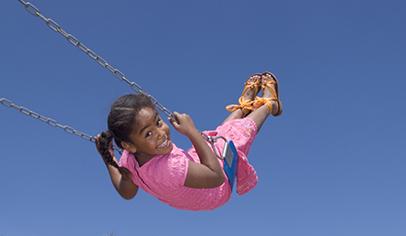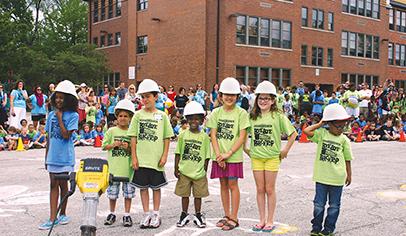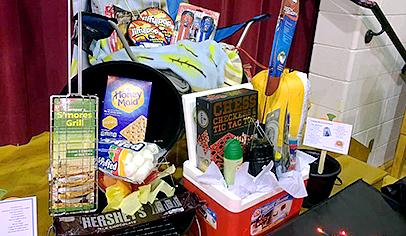The most important part of your school’s playground may be what’s underneath it. Have you checked lately to see what that surface looks like?
Every year parent groups across the country spend tens of thousands of dollars on new playground equipment. It’s a good investment, too. Playgrounds have improved tremendously. Monkey bars coated with lead paint and located above unforgiving asphalt have been replaced by equipment engineered for safety and child development.
Today’s playgrounds are not only fun for kids, they help children develop motor skills and coordination, imagination, confidence, and social skills.
But it’s easy to forget all that when a child gets hurt. And despite all of the consideration about safety, children do get hurt. The federal government estimates that 200,000 children are treated in emergency rooms every year for playground injuries.
Almost 60 percent of those injuries are from falls, so if you’re wondering how safe your school playground is, look down.
Asphalt and concrete, obviously, are out. Even soils and hard-packed dirt don’t absorb shocks well, and grass and turf are too susceptible to wear and environmental conditions. Instead, today’s playgrounds use loose fill or synthetics such as rubber as a surface. About 80 percent of all public playgrounds have appropriate surfacing (compared to only 9 percent of home playgrounds), according a 2001 survey by the U. S. Consumer Product Safety Commission. The CPSC tests materials to determine their effectiveness in preventing serious head injuries.
Just because your playground had proper surfacing when it was installed, however, doesn’t mean it still does. Surfacing must be inspected and maintained regularly, a task that often goes undone.
Surface Depth
Susan Hudson, education director for the National Program for Playground Safety at the University of Northern Iowa, says that parents and school officials need to inspect their playground covering with two measures in mind: the placement of the materials and their depth.
Surfacing comes in three types: organic loose fill, inorganic loose fill, and synthetics. Organic loose fill includes bark mulch; wood chips; and shredded hardwood, called engineered wood fibers. Inorganic loose fill includes sand and gravel.
Loose fill is relatively inexpensive, making it a popular choice for playground surfacing. It spreads easily, but that means the depth can change significantly. It might blow away, children might dig in it, or it might simply be tracked off the playground over time.
The CPSC publishes recommended depths of loose fill based on the type of fill and the height of the playground equipment. But there is a good rule of thumb.
“We recommend loose covering at least 9 and preferably 12 inches deep,” says Hudson. “And you need to look under slides, overhead ladders, and all the places where kids jump or land. In playgrounds across America, we’re doing a good job of having the right material but not a good job of having it at the right depth.”
It’s important to check the depth of your playground surface a few times a year. And the surface should be raked to redistribute the fill regularly, even weekly or daily, depending on how much use the equipment gets. Loose fill also tends to compact over time. When it becomes compacted, it becomes much less effective in absorbing shocks and thus, preventing injuries. Dig down into the material to make sure it hasn’t hardened, especially in high-impact areas such as the landing zone for the slide. Gravel, in particular, may need to be broken up occasionally.
Another issue with loose fill is that it hides materials such as broken glass and animal waste. Check regularly to make sure your surface is free of debris.
Synthetic surfacing includes rubber, rubber over foam mats or tiles, poured urethane, and rubber composites. These surfaces tend to be more expensive, and whether you can use them or not depends on factors such as how level the ground is. Synthetic materials need to be checked for wear, particularly in high-impact areas. Check to make sure the material hasn’t curled at the edges, which can be a tripping hazard. Also, look for cracks or other damage caused by frost.
One advantage of using mats rather than a poured synthetic surface, notes Hudson, is that they can be replaced individually. Just because the tiles under the slide are worn doesn’t mean the whole playground surface needs to be replaced. But be sure to use mats that are appropriately shock-absorbent and durable for playground use.
Placement
In addition to maintaining the depth of the surface, it’s important to make sure it is positioned properly. Materials need to be under all the equipment and extend at least six feet on all sides of stationary equipment, Hudson says. According to the CPSC, about half the time children fall on a playground, they fall off a piece of climbing equipment.
Swings and slides are the next trouble areas, causing about 36 percent of injuries. There are simple formulas for covering the areas around slides and swings.
For slides, covering should be six feet around the structure itself. In the landing area in front of the slide, the covering should extend a distance equal to the height of the slide, plus an additional two to four feet. For example, for a five-foot slide the landing area should be at least seven feet.
For swings, take the height and double it. For a swing eight feet tall, Hudson says, there should be good covering 16 feet in front of and 16 feet behind the swing. “The danger with swings is not just the swinging,” she says. “It’s that kids swing as high as they can and then jump off.”












